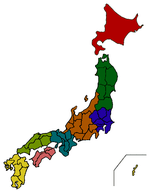Maruoka Castle
Maruoka Castle (丸岡城, Maruoka-jō) is a hirayama-style Japanese castle located in the Maruoka neighbourhood of the city of Sakai, Fukui Prefecture, in the Hokuriku region of Japan. It also called Kasumi-ga-jō (霞ヶ城, Mist Castle) due to the legend that whenever an enemy approaches the castle, a thick mist appears and hides it. Built at the end of the Sengoku period, the castle occupied by a succession of daimyō of Maruoka Domain under the Edo period Tokugawa shogunate, the site is now a public park noted for its sakura.
| Maruoka Castle 丸岡城 | |
|---|---|
| Sakai, Fukui Prefecture, Japan | |
 Donjon of Maruoka Castle | |
 Maruoka Castle 丸岡城  Maruoka Castle 丸岡城 | |
| Coordinates | 36°09′08″N 136°16′20″E |
| Type | hirayama-style Japanese castle |
| Site information | |
| Open to the public | yes |
| Site history | |
| Built | 1576 |
| Built by | Shibata Katsutoyo |
| In use | Sengoku-Edo period |
| Demolished | 1871 |
Background
Maruoka Castle is located on top of a small hill in the plains north of the city of Fukui. The area around the foot of the hill was levelled, and protected by ramparts and a pentagonal-shaped moat. The castle is located on the Hokurikudō highway connecting Kaga Province with Echizen Province, at the juncture of the Mino Kaidō highway connecting inland Mino Province with the Sea of Japan.
History
Maruoka Castle was constructed by Shibata Katsutoyo in 1576. Katsutoyo was nephew and adopted son of Shibata Katsuie, one of Oda Nobunaga's leading generals. After Shibata Katsutoyo died of illness during the Battle of Shizugatake in 1583, the castle was given to the Aoyama clan. However, the Aoyama sided with the Western Army under Ishida Mitsunari during the Battle of Sekigahara and were thus dispossessed by the victorious Tokugawa Ieyasu. Ieyasu awarded Echizen Province to his son, Yūki Hideyasu, who in turn created a 26,000 koku holding centered at Maruoka for his retainer, Imamura Moritsugu. In 1612, due to an O-Ie Sōdō within Fukui Domain, the Tokugawa shogunate raised Maruoka Domain to 40,000 koku and assigned it to Honda Narishige, the son of Honda Shigetsugu, one of Ieyasu's leading generals. Due to Honda Narishige's efforts at the Siege of Osaka in 1624, the kokudaka of the domain was further raised to 46,300 koku. His son and grandson completed the castle and the surrounding jōkamachi. However, his great-grandson, Honda Shigemasu was an alcoholic and incompetent, and was dispossessed by the shogunate in 1695. The Honda were replaced by Arima Kiyosumi, a descendant of the Kirishitan daimyō Arima Harunobu. The Arima clan continued to rule Maruoka for eighth generations until the abolition of the han system in July 1871. The castle remained property of the Arima until donated to the town in 1901.
Current situation
After the Meiji restoration, almost all Japanese castles around the country were destroyed; however, Maruoka Castle is one of just twelve castles remaining which managed to keep its original donjon. The relatively small, 3-story donjon claims to be the oldest in the country, a claim which is challenged by both Inuyama Castle and Matsumoto Castle. The donjon has a number of unique design features, including stone roof tiles and a hidden floor not apparent from the exterior, but in general is very similar to the contemporary Inuyama Castle in design.
The donjon collapsed during the 1948 Fukui earthquake, but was rebuilt in 1955 using 80% of the original materials. It was designated an Important Cultural Property in 1950. A number of the castle gates also survive in private hands, including one at the temple of Kōzen-ji in Komatsu, Ishikawa and one at the temple of Renshō-ji in the city of Awara, Fukui.
The former castle grounds are now a public park with a small museum, and contain some remnants of the ramparts and moats. The area is famed for its sakura trees in spring.
Literature
- Schmorleitz, Morton S. (1974). Castles in Japan. Tokyo: Charles E. Tuttle Co. pp. 144–145. ISBN 0-8048-1102-4.
- Motoo, Hinago (1986). Japanese Castles. Tokyo: Kodansha. p. 200 pages. ISBN 0-87011-766-1.
- Mitchelhill, Jennifer (2004). Castles of the Samurai: Power and Beauty. Tokyo: Kodansha. p. 112 pages. ISBN 4-7700-2954-3.
- Turnbull, Stephen (2003). Japanese Castles 1540-1640. Osprey Publishing. p. 64 pages. ISBN 1-84176-429-9.
